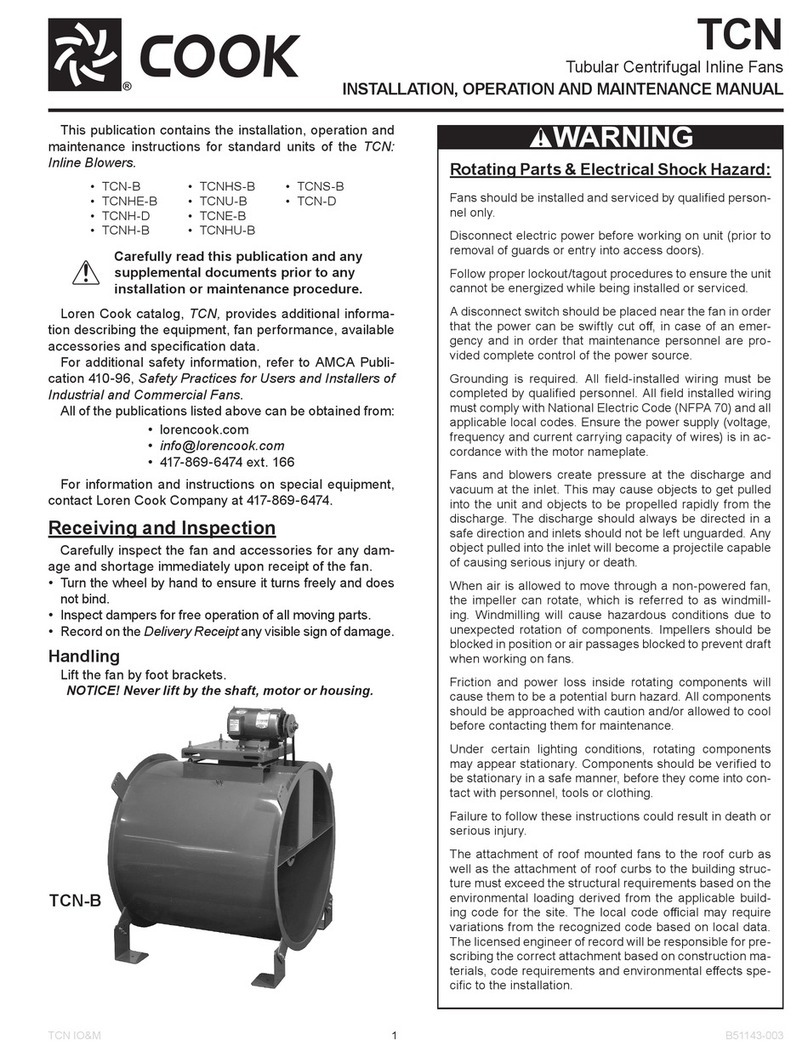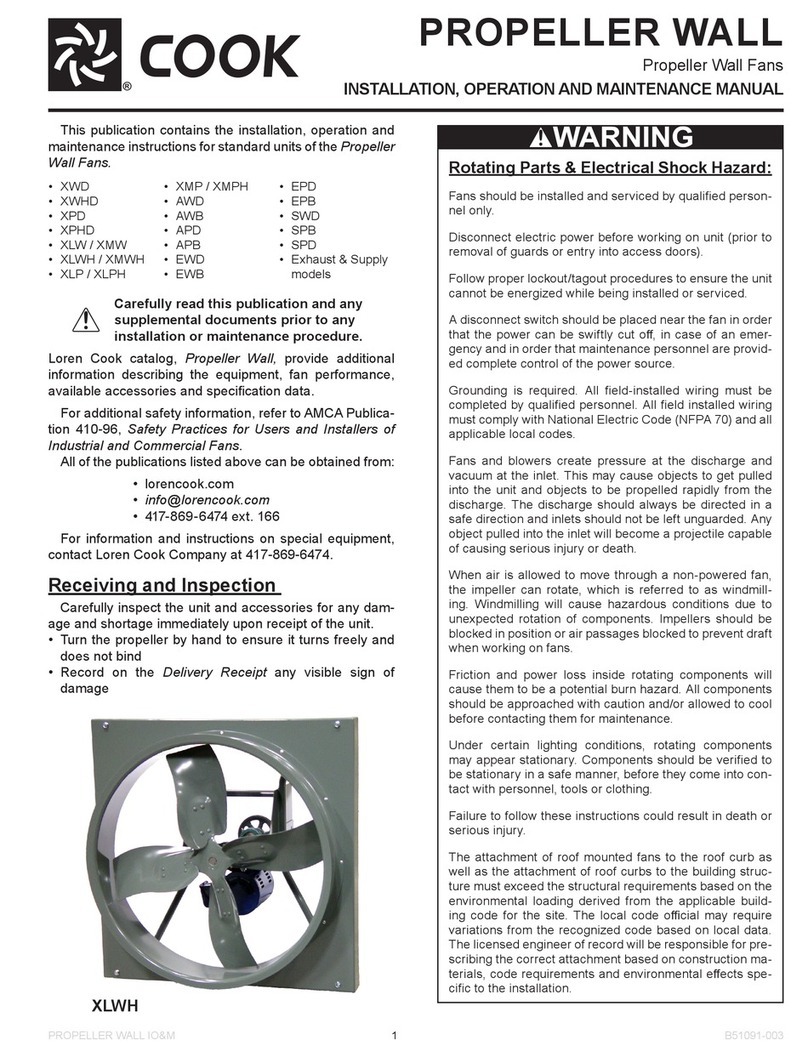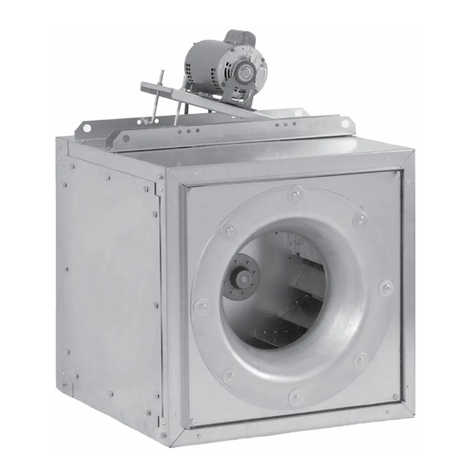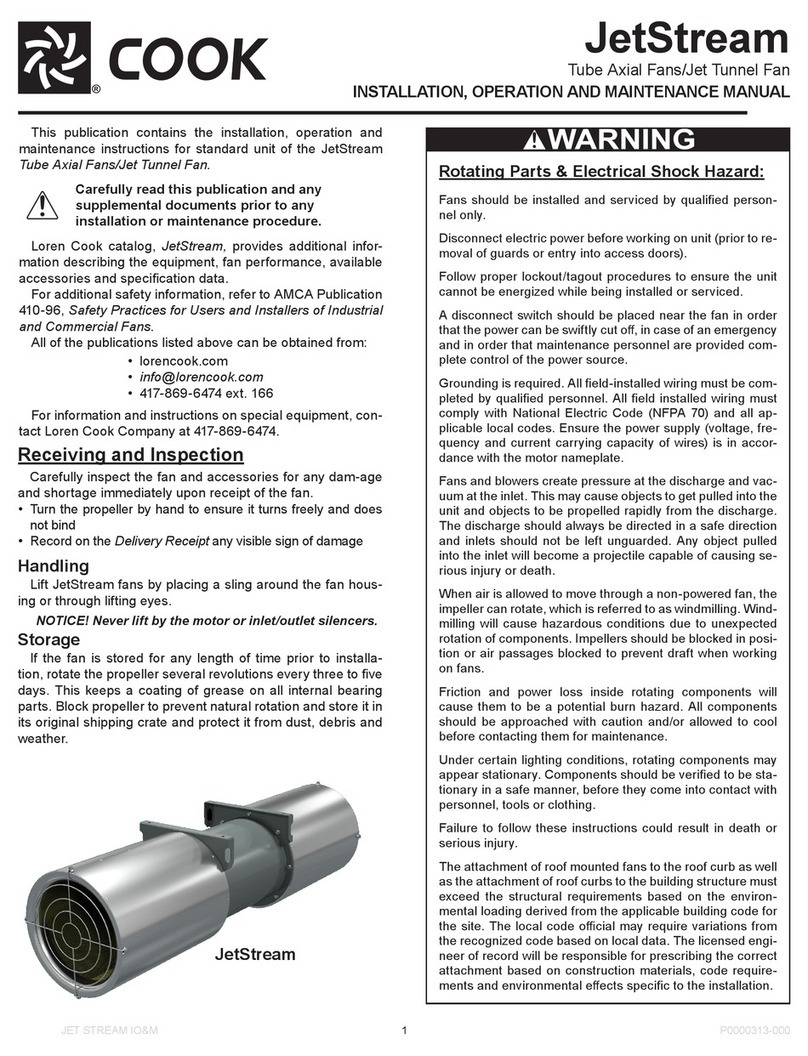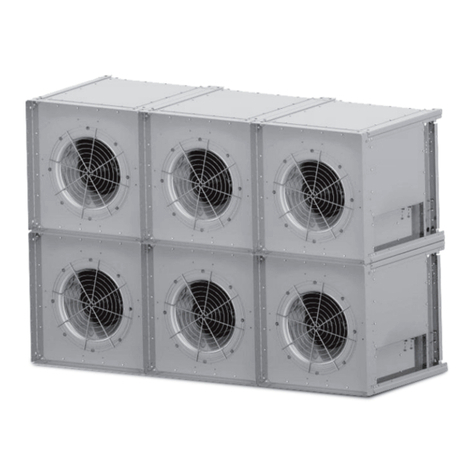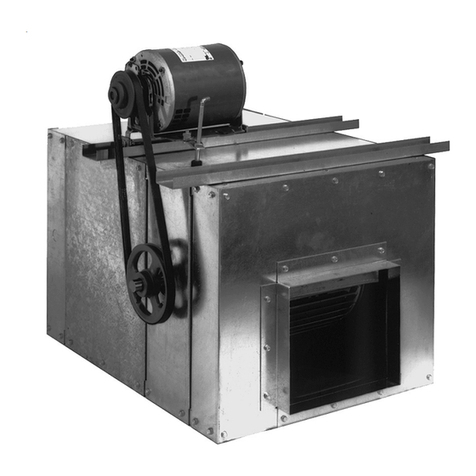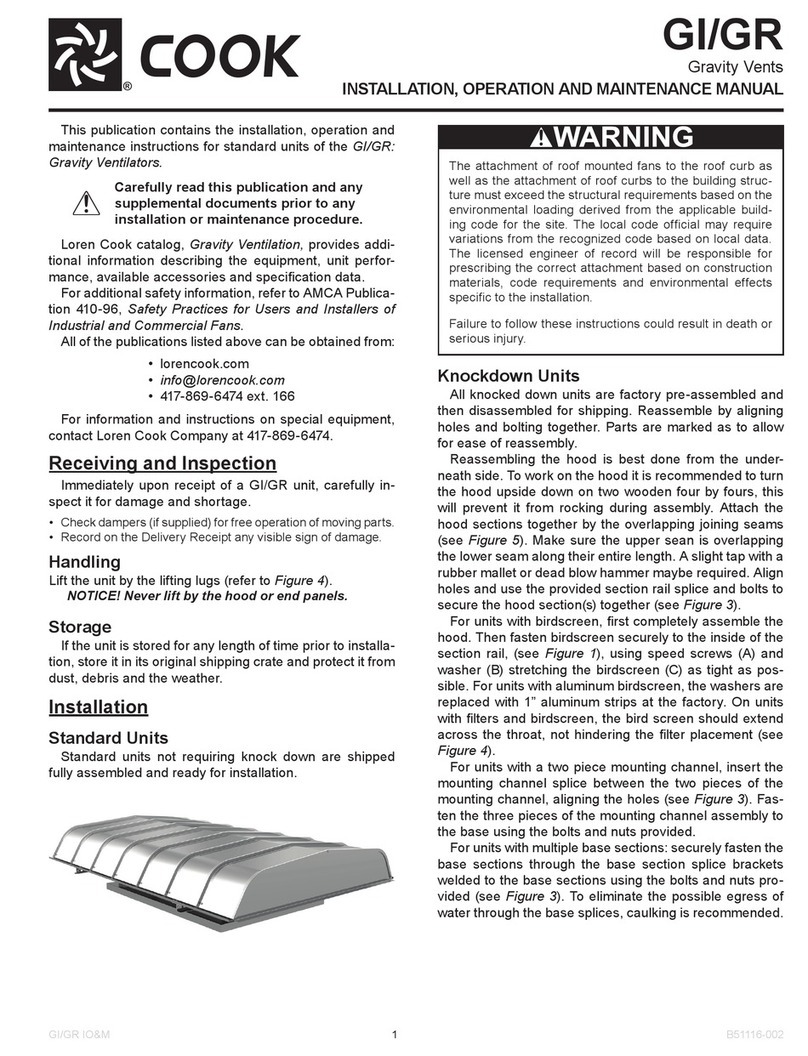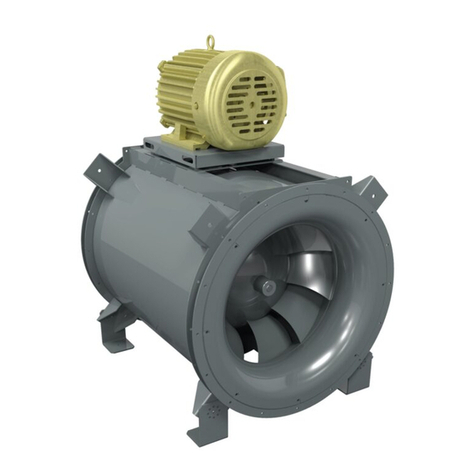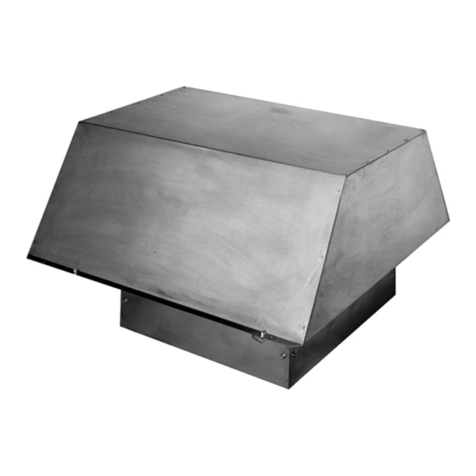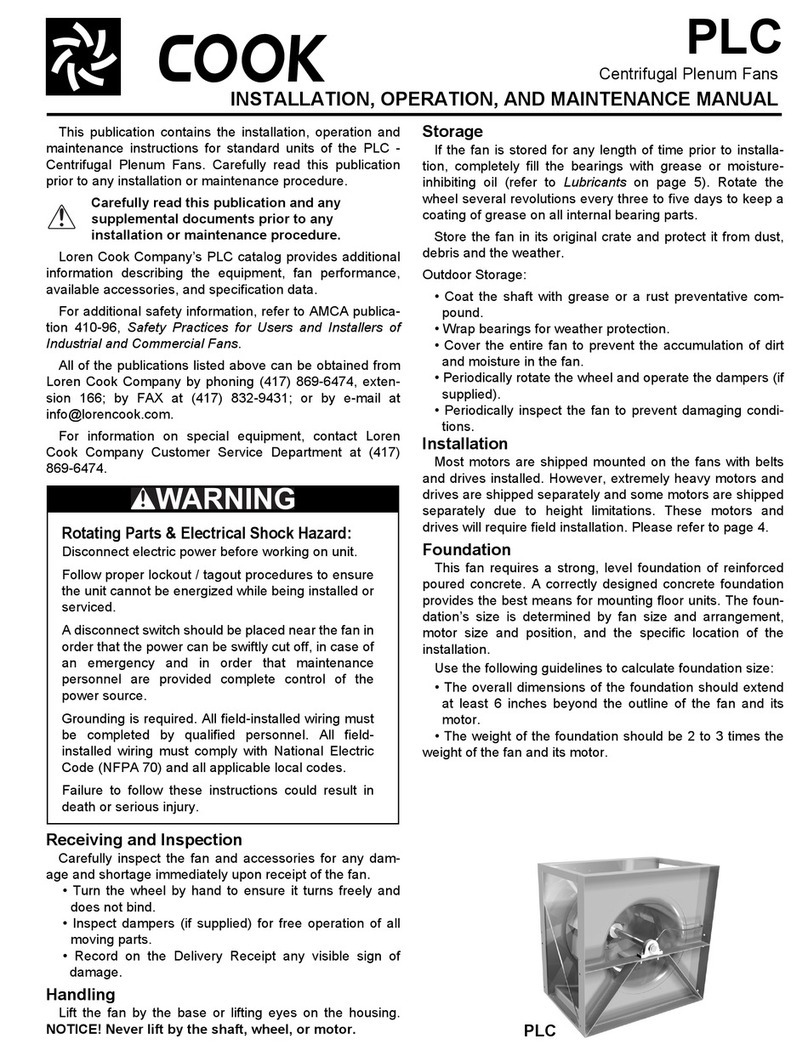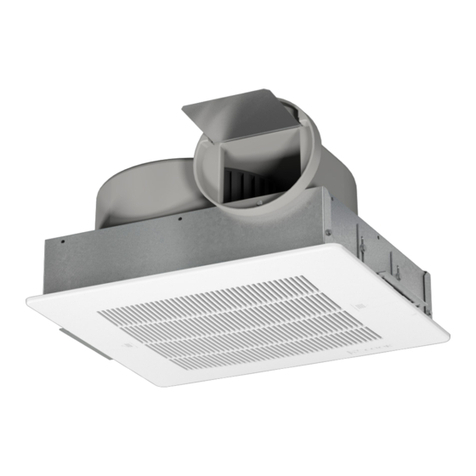
2FCE/FCRU IO&M B51150-003
1. Remove the top cap which covers the motor assembly
by unbolting the lid.
2. For internal wiring, run the electrical wire and conduit
through the opening drilled in the damper shelf (refer
to Damper Installation), then through the wiring con-
duit in the ventilator base to the motor compartment.
For external wiring, run the wires through the horizon-
tal conduit on upblast units, or under top cap in down-
blast units.
3. Pull the wires through and complete the wiring. For
further information. Refer to Wiring Diagrams on page
3.
Final Installation Steps
1. Ensure fasteners and set screws, particularly fan
mounting and bearing fasteners are tightened accord-
ing to the recommended torque shown on the table
below.
2. Inspect for correct amperage with an ammeter and
correct voltage with a voltmeter.
3. Ensure that all accessories are installed.
4. Test the fan to be sure the rotation is the same as indi-
cated by the arrow marked “Rotation.”
NOTICE! Do not allow the fan to run in the wrong
direction. This will overheat the motor and cause
serious damage. For 3-phase motors, if the fan is
running in the wrong direction, check the control
switch. It is possible to interchange two leads at
this location so that the fan is operating in the cor-
rect direction.
5. Inspect wheel-to-inlet clearance. Wheels may shift in
shipment. To realign wheel-to-inlet, shift upper bearing
so there is an equal radial clearance between the wheel
and inlet. Refer to Wheel to Inlet Clearance, page 6.
Recommended Torque for Setscrews/Bolts on Metal (IN-LB)
Setscrews Hold Down Bolts
Size
Key Hex
Across
Flats
Recommended
Torque Size Recommended
Torque
Min. Max.
#8 5/64” 15 21 3/8”-16 324
#10 3/32” 27 33 1/2”-13 780
1/4 1/8” 70 80 5/8 ”-11 1440
5/16 5/32” 140 160 3/4”-10 2400
3/8 3/16” 250 290 7/8”-9 1920
7/16 7/32” 355 405 1”-8 2700
1/2 1/4” 560 640 1-1/8”-7 4200
5/8 5/16” 1120 1280 1-1/4”-7 6000
3/4 3/8” 1680 1920 - -
7/8 1/2” 4200 4800 - -
19/16” 5600 6400 - -
Recommended Torque for Setscrews/Bolts on FRP (FT-LB)
Size (inches) 18-8 SST Hardware Torque
No. 10 7
1/4” 12
5/16” 20
3/8” 30
7/16” 41
1/2” 54
5/8” 86
3/4” 128
To maintain good working condition of the fan when it is
stored outdoors, follow the additional instructions below.
• Coat the shaft with grease or a rust preventative
compound.
• Wrap bearings for weather protection. Cover the inlet
and outlet to prevent the accumulation of dirt and mois-
ture in the housing.
• Periodically rotate the wheel and operate dampers (if
supplied). Periodically inspect the unit to prevent dam-
aging conditions.
Installation
If the fan was delivered with the motor unmounted, see
the maintenance section for belt and pulley installation.
Damper Installation
If your fan is supplied with dampers, follow the directions
below. If your fan does not include dampers, proceed to
Belt and Pulley Installation.
1. Place the damper inside the curb or inside the duct
work. Ensure the damper will open freely for the cor-
rect direction of the airow.
2. Secure to curb at the damper shelf.
3. Drill hole in the curb shelf for conduit needed for mo-
tor wiring.
4. Operate the dampers manually to ensure the blades
move freely.
5. Install fan over curb while aligning the conduit location
with the conduit hole in the curb.
Wiring Installation
NOTICE! All wiring should be in accordance with
local ordinances and the National Electrical Code,
NFPA 70. Ensure the power supply (voltage, fre-
quency, and current carrying capacity of wires) is
in accordance with the motor nameplate (see page
3 for diagram). Fan must be grounded to prevent
electrical discharge.
For Units Without A Junction Box:
An approved metal eld wiring compartment must be
secured to the unit with two screws in order that the box
does not rotate. All wires must be protected from abrasion
where they enter and exit the wiring compartment.
The green ground wire from the motor must be secured
under the green ground screws inside the eld wiring
compartment using a closed loop connector. Complete
connections in accordance with the wiring diagram on the
motor.
For Units With A Junction Box:
Pull wires through the appropriate conduit. Protect wires
from abrasion where they enter the eld wiring compart-
ment and complete connections in accordance with the
diagram on the motor.
Leave enough slack in the wiring to allow for motor
movement when adjusting belt tension. Some fractional
motors have to be removed in order to make the connec-
tion with the terminal box at the end of the motor.
NOTICE! Follow the wiring diagram in the discon-
nect switch and the wiring diagram provided with
the motor. Correctly label the circuit on the main
power box and always identify a closed switch to
promote safety (i.e., red tape over a closed switch).






